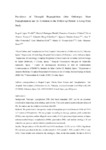Prevalence of tricuspid regurgitation after orthotopic heart transplantation and its evolution in the follow-up period: a long-term study

View/
Use this link to cite
http://hdl.handle.net/2183/31972Collections
- Investigación (FCS) [1293]
Metadata
Show full item recordTitle
Prevalence of tricuspid regurgitation after orthotopic heart transplantation and its evolution in the follow-up period: a long-term studyAuthor(s)
Date
2022-10-26Citation
López-Vilella R, Paniagua-Martín MJ, González-Vílchez F, Donoso Trenado V, Barge-Caballero E, Sánchez-Lázaro I, Aller Fernández AV, Martínez-Dolz L, Crespo-Leiro MG, Almenar-Bonet L. Prevalence of tricuspid regurgitation after orthotopic heart transplantation and its evolution in the follow-up period: a long-term study. Transplant Proc. 2022 Nov;54(9):2486-2489.
Abstract
[Abstract] Background. Tricuspid regurgitation (TR) after heart transplant (HT) can be an important complication depending on its etiology and severity. This study aims to analyze the prevalence of TR, the causes, and its evolution over time after HT.
Methods. We performed a retrospective study of transplants performed between 2000 and 2019 in 2 centers (1009 patients). TR was grouped according to etiology: primary graft dysfunction (PGD), acute rejection, cardiac allograft vasculopathy (CAV), pulmonary hypertension, prolapse, endomyocardial biopsy complication (EMB), pacemaker (PM), and unclear etiology (TR not related to any process and for which no justification was found).
Results. The prevalence of TR after HT was 19.8% (moderate: 13.2%, severe: 6.6%). Significant TR was more prevalent in the first months (month 1: 51%, month 3: 40%, month 6: 29%, 1 year: 24%). These results were related to the etiologies. Thus, in the first month, TR due to PGD is frequent and it is the only time when TR due to pulmonary hypertension appears. During the first 6 months, TR of unclear cause gains relevance, which tends to decrease over time. After 1 year, TR due to rejection predominates. After 5 years, TR is less frequent (< 10%) and related to long-term complications of HT, such as CAV, EMB, and those associated with PM.
Conclusions. The prevalence of TR after HT is 19.8%. Prevalence and etiology change over time. Initially it is usually related to PGD, in the medium-term to rejection and in the long-term to CAV and procedures such as EMB and PM.
Editor version
ISSN
0041-1345





